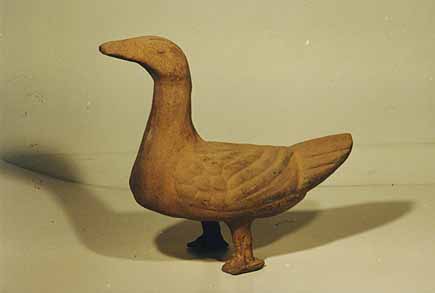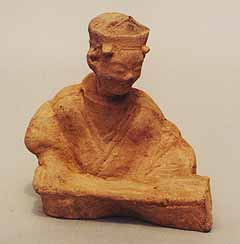The Han Dynasty's Tomb Figurine.
The Han Dynasty is one of the most interesting dynasties to study in term of artwork. The Han Dynastyís emperor established Chinese cultural patterns and it is created through a rebellion to the Qin Dynasty. In addition, its emperor believed in Confucianism and Daosim. Both of the religious and philosophical beliefs influenced a lot of ceramic figures and sculpture. Because of that, it supplied a lot of different themes and subjects for artwork. The Han emperor also had a lot of contact with countries outside of China. It also conquered as far as to Vietnam and Korea. These expansions reflected in the variety to be found in Han art. Also, Han people demanded glory even after life. A lot of tomb figurines were created because of that reason.
The ceramic duck (figure 1) is one kind of tomb figurine which buried along the noble.  This type of animal figurines usually are of clay alone. Some of it are of gray clay with a covering of white slip and some have olive or deep green lead glaze that deteriorates on burial and becomes iridescent. The gray clay with white slip is represented as being natural. The creator usually know the animal figures really well that no formal decoration is needed. This animal just serves as an accompanying figure to the occupant of the tomb. In addition to that, the animal shows magical qualities. These power figures started the ěSpiritual Pathsî. Therefore, animals figures serve as a guard and protector to the nobles and rulers to the next world.
This type of animal figurines usually are of clay alone. Some of it are of gray clay with a covering of white slip and some have olive or deep green lead glaze that deteriorates on burial and becomes iridescent. The gray clay with white slip is represented as being natural. The creator usually know the animal figures really well that no formal decoration is needed. This animal just serves as an accompanying figure to the occupant of the tomb. In addition to that, the animal shows magical qualities. These power figures started the ěSpiritual Pathsî. Therefore, animals figures serve as a guard and protector to the nobles and rulers to the next world.
Another tomb figurine is a sitting musician (figure 2). Beside natural animal, I believe that the dead needed entertainment; therefore, the family sent this little sitting musician along. This sitting musician is only 26.5 cm tall. He looks like he is really enjoying playing his instrument. Two- third of the whole figurine is concentrated on his top body and the rest is concentrated on his instrument. Notice his lower body is not showing at all. He looks down on his instrument and seems to enjoy it a lot.
Beside natural animal, I believe that the dead needed entertainment; therefore, the family sent this little sitting musician along. This sitting musician is only 26.5 cm tall. He looks like he is really enjoying playing his instrument. Two- third of the whole figurine is concentrated on his top body and the rest is concentrated on his instrument. Notice his lower body is not showing at all. He looks down on his instrument and seems to enjoy it a lot.
The other art work is a standing pottery figure of warrior (figure 3). (www.califmall.com/china25.jpg) This warrior looks more female than male. His shoulder is not really big and muscular. His whole body is thin. In spite of his height, only 67 cm tall, he seems relatively tall. But it does not show his ability as a warrior. The way he stands, however, shows his masculinity more. His hand motion especially allows the observer to know that he is a fighter. Despite his hand motions and the way he stands, this pottery shows a lot of stiffness.
Because Han is a dynasty which conquer other countries, the horse was very important to them. This standing bronze horse (figure 4) allows the observer to realize the importance of war and horse to the Han people.  This bronze horse is 56 inches tall and it is a special breed known as ě Celestial horse.î This type of horse is a very special model which was imported to China from the region west of China during the period 206 B.C.E to 220 C.E. The horse has a very strong and big body, slightly out of proportion to his legs. It shows the power of the owner and the emperor.
This bronze horse is 56 inches tall and it is a special breed known as ě Celestial horse.î This type of horse is a very special model which was imported to China from the region west of China during the period 206 B.C.E to 220 C.E. The horse has a very strong and big body, slightly out of proportion to his legs. It shows the power of the owner and the emperor.
The artworks above are interesting to study for they represent part of the Han Dynasty. They allow historian to study how important after death is to the Han people, even the Chinese people. Also, the different tomb figurines represent the different life style of the Han people. Despite all that, Han Dynasty is a very important dynasty to study because it was one of the strongest dynasty. A lot of southerner now from China still claim themselves the Han people.
References.
Lee, Sherman. A History of Far Eastern Art. Japan: Prentice Hall, Inc and Harry N. Abrams, Inc, 1994.
Webwind Production. THE WONDERING DRAGON
Virtur Tour. HAN DYNASTY (206B.C. to 220A.D.)
WRITTEN BYVIVIAN WAN.
DESIGNED BYKATHLEEN ENRIGHT.
(Basic Design, City College of San Francisco)
Back to Art in Asia, Table of Contents
 This type of animal figurines usually are of clay alone. Some of it are of gray clay with a covering of white slip and some have olive or deep green lead glaze that deteriorates on burial and becomes iridescent. The gray clay with white slip is represented as being natural. The creator usually know the animal figures really well that no formal decoration is needed. This animal just serves as an accompanying figure to the occupant of the tomb. In addition to that, the animal shows magical qualities. These power figures started the ěSpiritual Pathsî. Therefore, animals figures serve as a guard and protector to the nobles and rulers to the next world.
This type of animal figurines usually are of clay alone. Some of it are of gray clay with a covering of white slip and some have olive or deep green lead glaze that deteriorates on burial and becomes iridescent. The gray clay with white slip is represented as being natural. The creator usually know the animal figures really well that no formal decoration is needed. This animal just serves as an accompanying figure to the occupant of the tomb. In addition to that, the animal shows magical qualities. These power figures started the ěSpiritual Pathsî. Therefore, animals figures serve as a guard and protector to the nobles and rulers to the next world.
 Beside natural animal, I believe that the dead needed entertainment; therefore, the family sent this little sitting musician along. This sitting musician is only 26.5 cm tall. He looks like he is really enjoying playing his instrument. Two- third of the whole figurine is concentrated on his top body and the rest is concentrated on his instrument. Notice his lower body is not showing at all. He looks down on his instrument and seems to enjoy it a lot.
Beside natural animal, I believe that the dead needed entertainment; therefore, the family sent this little sitting musician along. This sitting musician is only 26.5 cm tall. He looks like he is really enjoying playing his instrument. Two- third of the whole figurine is concentrated on his top body and the rest is concentrated on his instrument. Notice his lower body is not showing at all. He looks down on his instrument and seems to enjoy it a lot.
 This bronze horse is 56 inches tall and it is a special breed known as ě Celestial horse.î This type of horse is a very special model which was imported to China from the region west of China during the period 206 B.C.E to 220 C.E. The horse has a very strong and big body, slightly out of proportion to his legs. It shows the power of the owner and the emperor.
This bronze horse is 56 inches tall and it is a special breed known as ě Celestial horse.î This type of horse is a very special model which was imported to China from the region west of China during the period 206 B.C.E to 220 C.E. The horse has a very strong and big body, slightly out of proportion to his legs. It shows the power of the owner and the emperor.